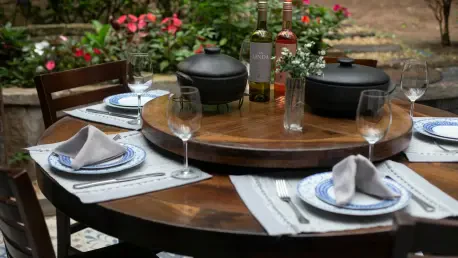In the realm of home improvement, outdoor dining spaces stand out as a powerful way to blend aesthetics with functionality, particularly during the warmer months. These spaces offer a sanctuary where meals can be enjoyed al fresco, immersing diners in natural surroundings, which enhances the sensory experience. The evolution of outdoor dining has witnessed significant transformations, with modern designs pushing the boundaries of creativity and comfort. From secluded garden spots to sleek terraces with panoramic views, these spaces echo an appreciation for nature while exuding personal style and cultural influences. The adaptability of these spaces underscores a broader trend toward versatile outdoor living. Let’s delve into some innovative dining concepts that not only improve quality of life but also elevate one’s connection with nature and design.
The Art of Design Integration
Embracing the Environment
Creating an outdoor dining area is an art that involves harmonizing the environment, materials, and aesthetics to complement each other. Central to this design philosophy is integrating the dining space with its natural surroundings. Using materials like wood, stone, and bamboo seamlessly blends the space into the landscape, offering an organic and visually appealing experience. Designers often draw inspiration from the locale’s natural beauty, ensuring that the dining area becomes an extension of the scenery rather than a standalone feature. For instance, a coastal setup might incorporate driftwood tables with rough stone elements, mimicking the rugged shoreline and creating a cohesive visual narrative.
Moreover, the choice of materials is crucial for ensuring durability and comfort. By selecting weather-resistant materials, designers can craft spaces that withstand the elements while maintaining aesthetic appeal. In regions with Mediterranean climates, robust textures like cobblestone and woven fabrics withstand the hot, arid conditions, creating a refuge that remains comfortable throughout variations in weather. Such choices not only enhance longevity but also provide a timeless quality, ensuring that the outdoor dining area remains a cherished feature for years to come.
Thoughtful Spatial Planning
Strategic planning of space can dramatically transform the usability and charm of an outdoor dining setting. Thoughtful placement, such as situating a dining table under a natural canopy or aligning it with a garden vista, amplifies the dining experience. These carefully planned placements not only capitalize on existing natural beauty but also create intimate settings that encourage relaxation and conversation. By employing spatial planning, designers ensure that dining areas facilitate both functional dining and leisurely lounging, making them versatile for diverse occasions.
Even small urban spaces can benefit from such planning, where creative configuration allows for a seamless flow between cooking, dining, and lounging areas. This adaptability is vital in maximizing the utility of limited space, ensuring that every square foot serves a purpose. Compact designs with multi-use furniture and retractable features allow easy transitions between dining and entertainment, making outdoor spaces an extension of indoor comfort. As these spaces double as social gathering points, thoughtful spatial organization helps manage foot traffic and provides enough room for movement, fostering a congenial atmosphere for activities.
Enhancing Experience Through Decor
The Power of Accessories
Accessories are pivotal in transforming an outdoor dining space from functional to magical, capturing the essence of dining under open skies. Thoughtful decor choices, such as vibrant tableware, colorful cushions, and textured throws, introduce personality and style. These elements not only add comfort but also reflect the homeowner’s tastes and preferences. The use of textiles with bold patterns and bright colors can reflect the vibrancy of the surrounding flora, creating a visual harmony that resonates with nature.
Lighting is another transformative accessory that can significantly enhance the dining ambiance. The strategic placement of lanterns, string lights, or chandeliers can create different mood settings, from intimate dinners to festive gatherings. Lighting features, such as solar-powered lanterns or fairy lights woven into pergolas, embellish the dining area, providing both illumination and decorative flair. Proper lighting design ensures that the outdoor dining experience is enjoyable well into the evening, extending its utility beyond daylight.
Cultural Inflections in Decor
Integrating cultural elements into outdoor dining decor can offer a unique, locale-specific touch that resonates with authenticity and warmth. By drawing on regional styles, homeowners and designers can infuse spaces with elements characteristic of a particular heritage or tradition. Whether incorporating rustic terracotta planters in a Tuscan-inspired space or adding Moroccan lanterns and rugs for an exotic flair, these cultural touches enrich the dining atmosphere with stories and character.
Cultural influences often manifest in the choice of furnishings and decorative motifs, introducing traditional craftsmanship and artisanal details. Handcrafted furniture or local sculptures can act as focal points, captivating guests with their narrative value and artistic merit. Additionally, using indigenous plants or native floral arrangements ties the space back to its geographical roots, enhancing its regional authenticity. Such cultural inflections not only honor traditions but also create a dining environment that is both intimate and distinctive, celebrating both personal and communal histories.
The Importance of Lighting and Ambiance
Innovative Lighting Solutions
Lighting is a crucial aspect in setting the mood and usability of outdoor dining areas. Innovative lighting solutions can transform an ordinary space into a captivating retreat that encourages prolonged use beyond daylight hours. From natural skylights to bespoke light fixtures, many designs incorporate technology that adapts to the time of day. Adjustable lighting, such as dimmable LED systems or color-changing installations, can be tailored to create various atmospheres, from romantic dinners to lively celebrations, enhancing the dining experience through tailored ambiance.
Natural light can also be optimized with thoughtful placements and structures. Pergolas or shaded areas fitted with recessed lighting allow for soft illumination during the evening while providing shade during the daytime. These design considerations not only enhance the aesthetic quality but also cater to practical needs, ensuring the space functions effectively across different times and occasions. Utilizing efficient solar lighting solutions further reflects a commitment to sustainability, making outdoor spaces both eco-friendly and elegant.
Enhancing Ambiance with Nature
Nature itself is an indispensable element in creating a welcoming and invigorating ambiance in outdoor dining areas. The strategic use of plants, water features, and natural sounds can elevate the sensory experience, crafting an immersive environment that resonates with tranquility. Lush greenery, from cascading ivy to flower-lined pathways, frames the dining space, introducing softness and vitality. The gentle rustle of leaves or the melodic splash of a fountain can act as soothing backdrops, enriching the dining atmosphere with calming natural acoustics.
Moreover, integrating natural elements lends visual depth and texture to the design, resulting in spaces that encourage exploration and relaxation. For example, placing a dining table near a rock garden or overlooking a pond invites diners into a multisensory experience, blurring the boundaries between the indoors and outdoors. These harmonious designs celebrate the organic beauty of the environment, inviting guests to partake in an experience that is as peaceful as it is invigorating. By incorporating nature into the fabric of outdoor dining areas, designers create spaces that transcend traditional dining, fostering moments of genuine connection and enjoyment.
Blending Functionality with Aesthetics
Furniture and Flexibility
In creating an outdoor dining area, the choice of furniture is essential, as it dictates the space’s comfort and functionality. Furniture must be versatile enough to serve multiple purposes, such as dining, lounging, and entertaining, to maximize the space’s utility. This adaptability is essential in smaller spaces, where multifunctional pieces like extendable tables, stackable chairs, or benches with storage can transform an ordinary patio into a dynamic entertaining hub. Outdoor furniture constructed from durable materials like wrought iron, teak, or rattan ensures longevity while providing options that suit various style preferences.
Flexibility is also mirrored in seating arrangements, where modular designs allow for customizable layouts that adapt to different occasions and group sizes. Modular outdoor sofas, sectional units, and movable ottomans allow space to be reconfigured as needed, promoting a fluid transition between dining and other activities. This flexibility ensures the space remains functional over time, catering to evolving needs and preferences, while still providing comfort. As outdoor living becomes a permanent extension of indoor life, stylish and functional furniture designs become pivotal in creating adaptable spaces.
Integrating Technology
Modern technology offers creative solutions to enhance outdoor dining experiences, merging functionality with cutting-edge design. Smart technology, such as integrated sound systems or outdoor televisions, caters to entertainment needs, transforming patios into multimedia experiences. Weatherproof electronics ensure reliability even in adverse conditions, allowing technology to become an enduring feature of outdoor spaces. Additionally, advancements like remote-controlled awnings or automated shading systems give homeowners control over comfort, facilitating a seamless shift from sunshine to shade.
For more sustainable designs, incorporating energy-efficient technology, like solar panels for lighting or induction heating for outdoor kitchens, aligns modern aesthetics with environmental consciousness. Automated irrigation systems can keep surrounding foliage lush and vibrant, maintaining the ambiance effortlessly. The use of technology not only elevates the level of comfort and ease but also reflects contemporary design sensibilities, offering innovative twists that enrich the overall dining experience. Technology allows for a heightened synthesis between form, function, and environmental awareness, firmly positioning outdoor dining as a modern luxury.
Capturing Personal Style and Identity
Personalized Accents
Outdoor dining spaces offer a unique opportunity to exhibit personal style, where choices in decor, furniture, and layout encapsulate an individual’s identity. Personalized accents, such as custom-made tables, curated plant selections, or bespoke lighting fixtures, create spaces that resonate with the homeowner’s taste and experiences. This personal touch imparts character into the design, ensuring that the dining area becomes a reflection of individual preferences and stories. Courtyards embellished with heirlooms or patios adorned with travel curios offer glimpses into the personalities of those who inhabit and design the space.
From heartfelt color palettes that evoke favorite memories to curated art pieces that symbolize cherished ideas, these individual touches breathe life into outdoor environments. Carefully selected artwork or sculptures can serve as focal points, offering conversational pieces that engage and intrigue visitors. By infusing these personal elements, outdoor dining locations become more than functional areas; they are manifestations of self-expression, spaces for guests to connect not just with the setting but also with the stories and sentiments intrinsic to its design.
Reflecting Cultural Narratives
Transforming outdoor dining areas through the lens of cultural narratives brings depth and tradition to these spaces. By thoughtfully incorporating cultural motifs and patterns, we create authentic stories that make dining experiences more meaningful and immersive. Whether celebrating the tranquility of a Japanese Zen garden or the vibrant elements of a Mediterranean courtyard with its colorful tiles and terra cotta accents, such influences highlight ethnic roots, historical depth, or regional charm. Utilizing ethnic patterns in textiles or decorating with regional artisanal crafts can reinforce a cultural theme’s authenticity.
These cultural elements maintain their integrity but also blend seamlessly with modern designs, creating a harmonious fusion that honors heritage while embracing contemporary styles. Features like a Mediterranean pizza oven or an Asian-inspired water feature can add both functionality and cultural context. This blend not only highlights cultural diversity but also encourages an appreciation of artistic traditions that shape outdoor dining design today. A dining space enriched with cultural layers captures the essence of global influences while reflecting personal connections, telling stories that traverse space and time.
Ultimately, outdoor dining serves as a transformative aspect of modern architecture, merging nature with design aesthetics to produce practical yet beautiful spaces. As homeowners increasingly seek to personalize outdoor areas, the focus on creating environments rich with stories that celebrate the connection between humanity, nature, and culture is paramount. This evolution promotes a lifestyle where outdoor dining spaces become joyous extensions of our homes and identities.









